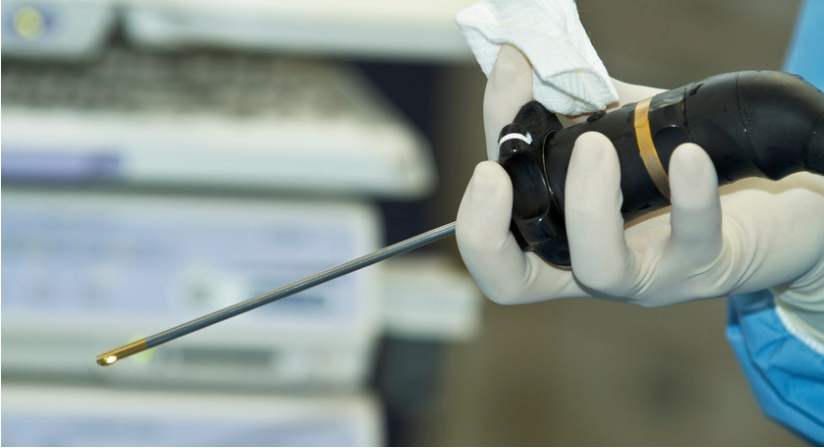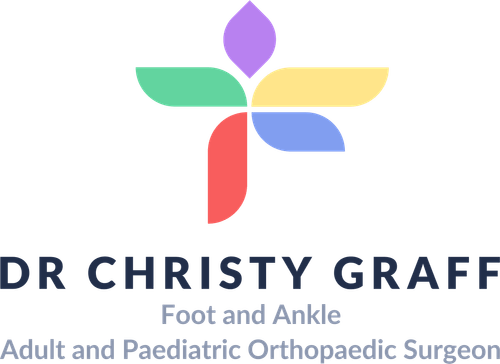Ankle Arthroscopy
What is Ankle Arthroscopy?
Ankle arthroscopy is a minimally invasive surgical procedure in which an arthroscope, a small, soft, flexible tube with a light and video camera at the end, is inserted into the ankle joint to evaluate and treat various conditions.
An arthroscope is a small fibre-optic instrument with a lens, light source, and video camera. The camera projects an image of the inside of the joint onto a large screen monitor, allowing the surgeon to look for damage, assess the type of injury, and repair the problem.

Indications for Ankle Arthroscopy
Ankle Arthroscopy, also referred to as keyhole surgery or minimally invasive surgery, has proved to be highly effective in managing various ankle disorders, including:
- Ankle arthritis (see Arthritis of the Foot and Ankle Information Sheet)
- Unstable ankle (See Ankle Instability Information Sheet and Ankle Stabilisation Surgery Information)
- Ankle fractures (see Ankle Fracture Information and Surgery Sheet and Syndesmosis Injuries Information and Surgery Sheets)
- Osteochondral defects of the talus
- Infection
- Undiagnosed ankle pain
Benefits of Ankle Arthroscopy
The benefits of arthroscopy compared to the alternative, open ankle surgery, include:
- Smaller incisions
- Minimal soft tissue trauma
- Less pain
- Faster healing time
- Lower infection rate
- Less scarring
- Earlier mobilisation
- Shorter hospital stay
Types of Ankle Arthroscopy
- Diagnostic Arthroscopy: Used to identify the cause of pain or dysfunction when other diagnostic methods are inconclusive.
- Therapeutic Arthroscopy: Performed to treat specific conditions such as ligament repairs, removal of bone spurs, or cartilage restoration.
- Debridement Arthroscopy: Involves cleaning out the joint by removing damaged tissue, loose bodies, or the inflamed synovium.
- Cartilage Repair: Procedures to restore cartilage, such as microfracture or grafting techniques.
The type of arthroscopy performed will depend on the patient’s specific condition and surgical goals.
Alternative Options to Ankle Arthroscopy
If ankle arthroscopy is not suitable, alternative treatments may include:
- Non-Surgical Options
- Physical Therapy: To strengthen the joint and improve mobility.
- Medications: Anti-inflammatory drugs to manage pain and swelling.
- Steroid Injections: To reduce inflammation and provide temporary relief.
- Orthotics: Custom shoe inserts to alleviate pressure and improve alignment.
- Surgical Alternatives
- Open Surgery: May be required for severe or complex conditions not manageable with arthroscopy.
- Ankle Fusion: For stabilising the joint in severe damage, deformity or pain cases.
- Lifestyle Modifications
- Weight loss, activity adjustments, and wearing supportive footwear can sometimes reduce symptoms and delay the need for surgery.
What to Do Before an Ankle Arthroscopy?
Preparation for ankle arthroscopy is essential to ensure a smooth procedure and recovery. Here are the key steps:
Medical Evaluation
- Consultation with Dr Graff: Discuss your symptoms, medical history, and the goals of the procedure.
- Imaging Tests: X-rays, MRI, or CT scans may be performed to assess the joint.
- Medications Review: Inform your doctor about any medications or supplements you’re taking. A few days before surgery, you may need to stop blood-thinning medications.
Preoperative Instructions
- Fasting: As instructed, avoid eating or drinking for at least 6–12 hours before the procedure.
- Arranging Transportation: Since it’s often an outpatient procedure, arrange for someone to drive you home.
- Lifestyle Adjustments: Avoid smoking or alcohol, as they can interfere with healing.
Prepare Your Home
- Set up a recovery area with essentials such as pillows, medications, and mobility aids (e.g., crutches or a walker).
- Remove tripping hazards to prevent falls during recovery.
Ankle Arthroscopy Procedure
Dr Graff will make two or three small incisions around the ankle joint. One of the incisions will be used to insert an arthroscope. A sterile solution will also be pumped into the joint to expand the joint area and create room for Dr. Graff to work.
The larger image on the television monitor allows Dr Graff to visualise the joint directly, determining the extent of damage and allowing it to be surgically treated. Surgical instruments will be inserted through the other tiny incisions to assess and treat the problem.
After the surgery, the instruments are removed, and the incisions are closed and covered with a bandage.
- Initially, Dr. Graff will make one to three incisions around your ankle joint and insert the arthroscope through the small incision. The arthroscope is then connected to a video monitor in the operating room, allowing Dr Graff to see inside your ankle more clearly.
- Inspect your ankle's tissues (bones, tendons, ligaments, and cartilage).
- Repair any damaged tissues. At the end of the treatment, Dr Graff will close the incisions with stitches and cover them up with a bandage.
Post-surgical Care After Ankle Arthroscopy
After the procedure, you will be taken to a recovery room. The ankle joint will be immobilised with a boot. The nature and duration of immobilisation will depend on the type of repair performed. The surgical site should be kept clean and dry during the healing process. Patients may be prescribed pain medication to manage pain. Elevation of the ankle and ice application helps to reduce pain and swelling. Follow your post-operative instructions for the best outcome.
- Some patients are allowed to bear weight with crutches
- Others might be placed in a boot or plaster for some time (six weeks). The determinant factors for immobilising your ankle are the type of repairs made during the procedure.
Generally, the area where the treatment was performed will be kept clean and dry while the incisions are healing.
Ankle Arthroscopy Rehabilitation
All patients are different, and these timelines are only a guide. Some may progress faster or slower than others.
First Week Post-Surgery
- Rest and Elevation: Keep your ankle elevated to reduce swelling.
- Cold Therapy: Apply ice packs as recommended to control pain and inflammation.
- Limited Mobility: Use crutches to avoid putting weight on the ankle. Keep your boot on full-time and use bags for showers.
- You will need medications for pain relief: regular paracetamol (2 tablets 4 times a day) as well as a strong pain killer, especially at night.
- You will need to take either aspirin or clexane injections to prevent blood clots (2-6 weeks)
- You will need to take vitamin C 1g daily for 6 weeks
Weeks 2–3
- Gradual Weight-Bearing: This timeline depends on the type of surgery you have had
- Physical Therapy: Start gentle exercises to restore mobility and prevent stiffness.
- Wound Care: Keep the surgical site clean and dry.
Weeks 6-8
- Increased Activity: Rehabilitation depends on the other procedures performed, but you will likely be allowed to full weight bear in the boot at this stage
- Strengthening Exercises: Focus on regaining strength and balance with physiotherapy.
Months 2–6
- Return to Normal Activities: Low-impact activities can usually resume in 8–12 weeks.
- Sports and High-Impact Activities: Depending on the condition treated, full recovery and return to high-impact sports may take 4–6 months.
Ankle Arthroscopy Prognosis
The prognosis following ankle arthroscopy is generally positive, with many patients experiencing significant relief from symptoms and improved joint function. The procedure's success largely depends on the treatment condition, your overall health, and adherence to postoperative rehabilitation. Ankle Arthroscopy Risks and Complications
While complications from ankle arthroscopy are uncommon, the procedure poses some risks you must be aware of.
The most common complication of an ankle arthroscopy procedure is that it might injure the tendons or nerves surrounding the ankle joint. Additionally, using arthroscopy instruments can lead to infection and damage to the joint cartilage.
Some risks associated with ankle arthroscopy are bleeding, damage to blood vessels, pain syndrome and compartment syndrome. Lastly, once the patient heals, there is a risk that the pain will not be completely relieved.
Implications of Delaying Ankle Arthroscopy
Postponing ankle arthroscopy can lead to several consequences:
- Progression of Condition: Delaying treatment might allow the underlying issue to worsen, potentially leading to more severe symptoms or complications.
- Increased Pain and Dysfunction: Ongoing symptoms can interfere with daily activities and reduce the quality of life.
- Limited Treatment Options: As conditions progress, they may become less responsive to minimally invasive procedures, necessitating more extensive surgeries.
Useful Websites
- Healthdirect Australia: Provides comprehensive details on ankle arthroscopy, including benefits, risks, and recovery expectations.
Contact Us
If you want more information or have any questions or problems, please contact Dr Graff at admin@christygraff.com or call the rooms at 0493 461 133.
